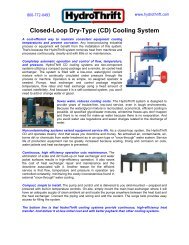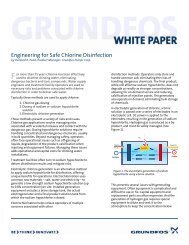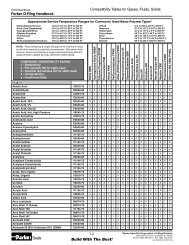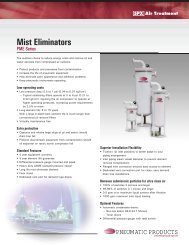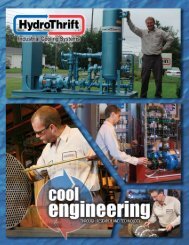Cross reference guides, application and ... - INSCO Group
Cross reference guides, application and ... - INSCO Group
Cross reference guides, application and ... - INSCO Group
- No tags were found...
You also want an ePaper? Increase the reach of your titles
YUMPU automatically turns print PDFs into web optimized ePapers that Google loves.
Glossary (continued)Mechanical Fitting or Reusable Fitting: A fitting notpermanently attached to a hose which can be disassembled <strong>and</strong>used again.Medium (Singular)/Media (Plural): The substance(s) beingconveyed through a piping system.Minimum Bend Radius: The smallest radius to which a hose canbe bent without suffering permanent deformation of its convolutions.Misalignment: A condition in which two points, intended to beconnected, will not mate due to their being laterally out of line witheach other.Nominal Diameter: A term used to define the dimensions of acomponent. It indicates the approximate inside diameter.Offset – Lateral, Parallel, & Shear: The amountthat the ends of a hose assembly are displaced laterally in relation toeach other as the result of connecting two misaligned terminations in apiping system, or intermittent flexure required in a hose <strong>application</strong>.Operating Conditions: The pressure, temperature, motion, media,<strong>and</strong> environment that a hose assembly is subjected to.Outside Diameter: This refers to the external diameter of a metalhose, measured from the top of the corrugation or braiding.Penetration (Weld): The percentage of wall thickness of the twoparts to be joined that is fused into the weld pool in making a joint. Ourst<strong>and</strong>ard for penetration of the weld is 100 percent, in which the weldgoes completely through the parent metal of the parts to be joined <strong>and</strong> isvisible on the opposite side from which the weld was made.Percent Of Braid Coverage: The percent of the surface area of ahose that is covered by braid.Permanent Bend: A short radius bend in a hose assembly used tocompensate for misalignment of rigid piping, or where the hose is used asan elbow. Hose so installed may be subjected to minor <strong>and</strong>/or infrequentvibration or movement.Pipe Gap: The open space between adjacent ends of two pipes in whicha hose assembly may be installed.Pitch: The distance between the two peaks of adjacent corrugation.Ply, Plies: The number of individual thicknesses of metal used in theconstruction of the wall of a corrugated hose.Pressure: Usually expressed in pounds per square inch (PSI) <strong>and</strong>,depending on service conditions, may be applied internally or externallyto a hose.a. Absolute Pressure – A total pressure measurement system inwhich atmospheric pressure (at sea level) is added to the gagepressure, <strong>and</strong> is expressed as PSIA.b. Atmospheric Pressure – The pressure of the atmosphere atsea level which is 14.7 PSI, or 29.92 inches of mercury.c. Burst Pressure (Actual And Rated)1. Actual – Failure of the hose determined by the laboratorytest in which the braid fails in tensile, or the hose ruptures,or both, due to the internal pressure applied. This test isusually conducted at room temperature with the assembly in astraight line, but for special <strong>application</strong>s, can be conducted atelevated temperatures <strong>and</strong> various configurations.2. Rated – A burst value which may be theoretical, or apercentage of the actual burst pressure developed bylaboratory test. It is expected that, infrequently, due tomanufacturing limitations, an assembly may burst at thispressure, but would most often burst at a pressure greaterthan this.d. Deformation Pressure (Collapse) – The pressure at whichthe corrugations of a hose are permanently deformed due to fluidpressure applied internally, or, in special <strong>application</strong>s, externally.e. Feet of Water or Head Pressure – Often used to expresssystem pressure in terms of water column height. A column ofwater 1 ft. high exerts a .434 PSI pressure at its base.f. Proof Pressure or Test Pressure – The maximum internalpressure which a hose can be subjected to without eitherdeforming the corrugations, or exceeding 50 percent of the burstpressure. When a hose assembly is tested above 50 percent of itsburst pressure, there often is a permanent change in the overalllength of the assembly, which may be undesirable for certain<strong>application</strong>s.g. PSIA – Pounds per square inch absolute.h. PSIG – Pounds per square inch gauge.i. Pulsating Pressure – A rapid change in pressure above<strong>and</strong> below the normal base pressure, usually associated withreciprocating type pumps. This pulsating pressure can causeexcessive wear between the braid <strong>and</strong> the tops of the hosecorrugations.j. Shock Pressure – A sudden increase of pressure in hydraulicor pneumatic system, which produces a shock wave. This shockcan cause severe permanent deformation of the corrugations in ahose as well as rapid failure of the assembly due to metal fatigue.k. Static Pressure – A non-changing constant pressure.l. Working Pressure - The pressure, usually internal, butsometimes external, imposed on a hose during operatingconditions.DS-EN-1000 (05)800-232-3539 610-367-2260 Fax 877-647-4011 www.penflex.com sales@penflex.com 28pflex.catalog_090403.indd 284/6/09 6:04:47 PM



